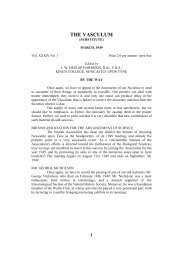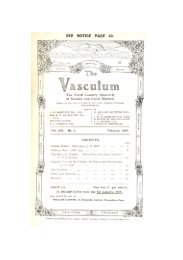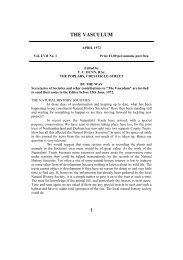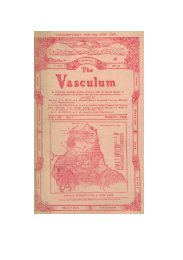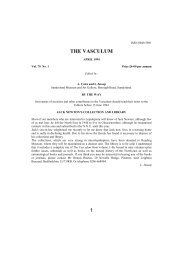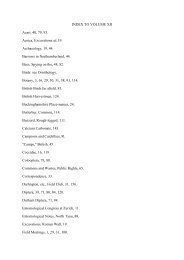1938 - The Vasculum
1938 - The Vasculum
1938 - The Vasculum
Create successful ePaper yourself
Turn your PDF publications into a flip-book with our unique Google optimized e-Paper software.
41<br />
In some cases for purposes of comparison I have given quotations<br />
from Chapman's and Bolam's Works. <strong>The</strong>se are numbered, and references<br />
will be found at the end of this paper.<br />
SHELD-DUCK: I saw ten of these birds on Fenham Flats on the<br />
1st June, and 54 on Budle Bay on the 6th June. On Holy Island it was<br />
plentiful on the 12th June. Occasional broods of young were seen. Bolam<br />
remarked that numbers varied considerably for no apparent reason, and the<br />
year 1937 would appear to have been a year of plenty.<br />
WIGEON: This bird has bred occasionally at some of our inland<br />
loughs since 1912, and it appears to be possible that it is now breeding near<br />
the coast. I was told locally that it did so, and there may be some truth in the<br />
story, as I saw a single drake north of Fenham Flats on the 1st June; a pair at<br />
the same place on the 5th June; and a pair on Budle Bay on the 6th June.<br />
COMMON SCOTER: <strong>The</strong>re was a flock of some 300 off<br />
Bamburgh on the 4th June.<br />
MANX SHEARWATER: I saw a single bird on the wing near the<br />
Farne Islands on the 9th June. This species has been seen here on several<br />
occasions at the breeding season, but has never been proved to breed.<br />
OYSTER-CATCHER: <strong>The</strong>re were nearly always a few about;<br />
larger numbers were 45 Fenham Flats on the 8th June, 50 Goswick sands<br />
10th June, 30 Holy Island 12th June. As this bird takes more than one year<br />
to grow to maturity, most of these would presumably be immature birds.<br />
RINGED PLOVER: Bolam wrote: "Large migratory flocks visit<br />
the coast ... sometimes as late as the end of May." (A.I). As I saw flocks of<br />
50 to 100 birds on the 3rd, 5th, and 7th June, I think this migration spreads<br />
over into June. Our local birds were breeding plentifully along the coast.<br />
GOLDEN PLOVER: Bolam said: -" On the coast the home-bred<br />
birds begin to appear early in August" (B.1). He should, I think, have said<br />
about the middle of July, as I saw a flock of about 300 birds on Fenham<br />
Flats on the 17th July, and these could only have been British breeding<br />
birds. Eight days later there was only one Golden on the same area, so this<br />
flock had probably already moved south. Chapman remarked of the Golden<br />
Plover that "<strong>The</strong>ir southern migration commences in July" (C. 1).



